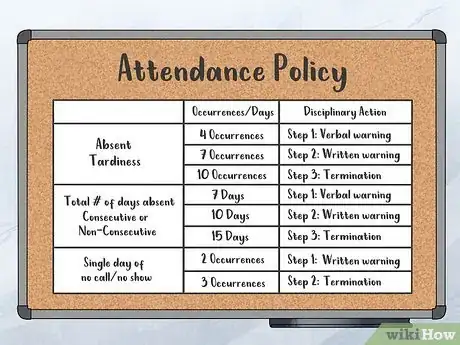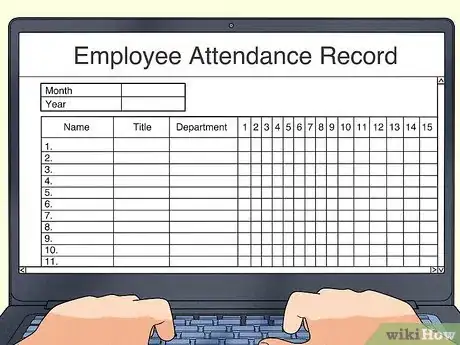This article was co-authored by wikiHow Staff. Our trained team of editors and researchers validate articles for accuracy and comprehensiveness. wikiHow's Content Management Team carefully monitors the work from our editorial staff to ensure that each article is backed by trusted research and meets our high quality standards.
wikiHow marks an article as reader-approved once it receives enough positive feedback. In this case, several readers have written to tell us that this article was helpful to them, earning it our reader-approved status.
This article has been viewed 139,017 times.
Learn more...
Absenteeism on the job is a major problem for many businesses. As a manager, your task is to implement a clear policy regarding time off, and to use your judgment and knowledge of this policy to make a decision concerning how to deal with any cases of excessive absenteeism. You must respond quickly, directly, and consistently to any problems with attendance. However, if you are dealing with an employee who has excessive absences, you must also be sensitive and determine if there is a compelling reason for the missed time.
Steps
Assessing the Problem
-
1Consider if there is a legitimate reason for the absenteeism.[1] Sometimes, employees have compelling reasons for being absent. An effective manager will accommodate and understand if an employee has a good reason for not attending work, especially if he or she can explain the absence ahead of time. Depending on your company’s policy and the employee’s situations, permissible absences might have reasons including:[2]
- Sick leave
- Maternity leave
- Bereavement
- Routine medical appointments
- Accommodations for disabilities
- Military leave
- Court appearances
- Jury duty
- Voting
- Approved time off
- Religious holidays
-
2Understand what unexcused absences can mean.[3] If you cannot determine that there is a legitimate reason for an employee’s absences, or if they are excessive, you will want to take steps to deal with the situation. The exact definition of “excessive” will depend on your company’s policies and expectations for employees. Common examples of the misuse of employee leave include:[4]
- Frequent brief periods of absences for “emergencies” or “illnesses” that do not seem to be documented.
- Frequent requests for absences just before or after holidays or other breaks.
- Repeated absences on the same day of the week or at the same time.
- Requests for absences at undesirable times (such as periods of peak workload).
- Absences just before or after the employee receives notice of unsatisfactory performance.
- Requests for sick leave or emergency leave after a request for regular leave was denied.
- The amount of time the employee has been absent approaches or exceeds the amount of time the employee has worked.
Advertisement -
3Don’t ignore the problem.[5] While it may not be pleasant, if an employee has a problem with excessive absenteeism, it is necessary to deal with it. As a manager or employer, you cannot ignore the problem.
- Having and enforcing sound policies is essential for creating an effective workplace.
- If other employees see an employee get away with excessive absenteeism, their morale will be lowered and they may increase their own absences.
- At a fundamental level, the employee-employer relationship is about showing up and doing the work; if an employee is absent excessively and cannot do his or her work, then that relationship is violated.
-
4Assess your management style. Perhaps even more difficult than addressing an employee’s excessive absenteeism is recognizing that you may have played a role in causing it. Sometimes, however, management style can be a contributing factor in excessive absenteeism and other workplace problems. If you are not managing effectively, your employees may feel resentful and miss work as a result. Consider:
- Do your employees feel valued?
- Do you treat all employees fairly?
- Do you consistently enforce policies regarding absences and other issues?
- Do you make it easy for employees to communicate with you about problems and concerns?
Finding a Solution
-
1Set up a meeting.[6] To directly address an employee’s absenteeism, set up a meeting between yourself, the employee, and any other relevant individuals (such as another supervisor or human resources representative, if applicable) to discuss the situation.
- Be proactive. Schedule a meeting as soon as you notice the problem, or it is brought to your attention.
- Let the employee know the purpose of the meeting. The point is not to blindside the employee, but to let both sides communicate, determine the facts, and decide on a course of action.
- Don’t assume that there is an inexcusable reason for the employee’s absences. Instead, offer to set up a meeting so that everyone can be clear with each other and understand the situation.
-
2Give the employee a chance to explain. Before deciding how to deal with the absenteeism, let the employee explain if there were any legitimate reasons for missing work. If the absences were due to a misuse of leave time or a violation of workplace policies, let the employee discuss any plans he or she has for improving in the future. You can use the employee’s explanation, if any, when determining what to do about the excessive absenteeism.
- As an employer or manager, you can ask an employee to explain absenteeism, and ask for documentation (such as a doctor’s note) if necessary.
- After hearing from the employee, explain any policies or expectations your workplace has regarding absenteeism.
-
3Make a decision and get it in writing.[7] If your workplace has an explicit policy regarding absenteeism, and the employee is in violation of that policy, then you will have to act in accordance with that policy. Otherwise, your decision will be based on the facts or explanation presented by the employee, your management style, and your own sense of judgment. Whatever your decision, make a written statement of it; deliver it to the employee and human resources office (if applicable), and keep a copy for your records. Some options include:
- You may issue a formal warning to the employee, explaining that future absenteeism will result in more severe consequences.
- You may require the employee to have special permission for any future absences.
- You may decide to remove certain privileges from the employee, such as the opportunity to choose shifts.
-
4Terminate the employee, if necessary. Termination is a severe consequence, even for excessive absenteeism. If you are thinking of terminating an employee due to excessive absenteeism, make sure it is necessary—for example, the employee has no legitimate explanation for the absences, and/or continues the behavior even after you meet to discuss the problem. In addition, you must make sure that termination is permissible according to any relevant employment contracts, workplace policies, and laws.[8]
- If you plan to terminate an employee, consider sending him or her a written notice and explanation beforehand.[9]
- Usually, you cannot terminate an employee on grounds of absenteeism if you only expect that the employee will miss excessive amounts of work; instead, there must be an actual record of absenteeism.[10]
Preventing Absenteeism
-
1Develop a clear absenteeism policy.[11] Many instances of absenteeism can be prevented if your workplace institutes a clear, written policy regarding leave and work time. If your workplace does not have one, work with your human resources department or other managers to develop one. This policy should outline things such as how to properly request leave, what level of absenteeism is considered a problem, and how excessive absenteeism will be dealt with.
- Once the policy is developed, be sure to implement it and enforce it consistently.[12]
- Make sure that your policy accounts for any applicable laws regarding acceptable absences for reasons such as maternity leave, medical leave, bereavement, etc.[13]
- You should also consider whether you want to treat excessive tardiness as an issue of absenteeism.[14]
- While it is important that an absenteeism policy is clear, it is also often prudent to reserve some flexibility.[15] This will allow managers to use their discretion when necessary.
-
2Track employee attendance.[16] You can help employees follow workplace policies, and know where they stand in terms of work time and absences, by tracking their attendance. If your employees are compensated hourly, their time and attendance is already tracked; you can help them, however, by making sure that this information is available to them at all times. Other types of employees can chart their attendance by formally recording days worked and leave time, by using an electronic entry system, a paper form, or some other means.
- Some employers institute a point system. For example, employees can earn points for regular and/or consecutive attendance; these points can then be redeemed as necessary for leave or absences. If you implement such a system, make sure that it does not put employees on approved leave (such as maternity leave or bereavement) at a disadvantage.
- You might also institute incentive plans to reward good employee attendance.[17] These can range from fun and silly (employees with good attendance records can display a work mascot at their desk, for instance) to competitive (for instance, perks such as gift cards to a restaurant can be earned by working a certain number of days consecutively).
-
3Institute performance reviews. Scheduled performance reviews with each employee, perhaps once or twice a year, can improve the workplace environment. If you have regular meetings with your employees, you may have the opportunity to discuss any absenteeism before it becomes excessive, as well as a chance to discuss overall work performance.
Community Q&A
-
QuestionWhat do I write to terminate an employee for excessive absences?
 Community AnswerIt depends where in the world you are and the employee are. Google employer and employee rights for the location and treat it as a guide. You may need to consult a lawyer just in case.
Community AnswerIt depends where in the world you are and the employee are. Google employer and employee rights for the location and treat it as a guide. You may need to consult a lawyer just in case. -
QuestionHow do I deal with excessive absenteeism if I have already issued a final warning?
 Community AnswerIf you issued a final warning and the employee was absent again, it is time to terminate them. Otherwise, you'll be sending the message that your warnings mean nothing.
Community AnswerIf you issued a final warning and the employee was absent again, it is time to terminate them. Otherwise, you'll be sending the message that your warnings mean nothing. -
QuestionHow can I manage my attendance and tardy issues?
 Community Answer1. Get a friend or family member to help with keeping you accountable - this can be done with reinforcing rewards, or by enforcing an unpleasant punishment, such as losing your phone for the day. 2. Set alarms on your phone to remind you to start getting ready for events and alarms to remind you to leave in order to reach your destination on time. 3. Give yourself extra time to account for sluggishness or unplanned events like bad traffic. 4. Find reasons to care about what you're attending. This will make you less likely to put off going. (E.g. work might not be fun, but you're earning money to pay for Netflix. School sucks, but you get to make memories with your friends.)
Community Answer1. Get a friend or family member to help with keeping you accountable - this can be done with reinforcing rewards, or by enforcing an unpleasant punishment, such as losing your phone for the day. 2. Set alarms on your phone to remind you to start getting ready for events and alarms to remind you to leave in order to reach your destination on time. 3. Give yourself extra time to account for sluggishness or unplanned events like bad traffic. 4. Find reasons to care about what you're attending. This will make you less likely to put off going. (E.g. work might not be fun, but you're earning money to pay for Netflix. School sucks, but you get to make memories with your friends.)
References
- ↑ http://www.hrvoice.org/keeping-workers-at-work-managing-absenteeism-in-the-workplace/
- ↑ http://www.personnel.wv.gov/SiteCollectionDocuments/Toolboxes/Attendance%20Mgt.pdf
- ↑ http://www.hrvoice.org/keeping-workers-at-work-managing-absenteeism-in-the-workplace/
- ↑ http://www.personnel.wv.gov/SiteCollectionDocuments/Toolboxes/Attendance%20Mgt.pdf
- ↑ http://www.hrvoice.org/keeping-workers-at-work-managing-absenteeism-in-the-workplace/
- ↑ http://www.hrvoice.org/keeping-workers-at-work-managing-absenteeism-in-the-workplace/
- ↑ http://conference.ohioschoolboards.org/2014/wp-content/uploads/sites/3/2014/11/2PM1110C213Britton.pdf
- ↑ http://www.hrvoice.org/keeping-workers-at-work-managing-absenteeism-in-the-workplace/
- ↑ http://conference.ohioschoolboards.org/2014/wp-content/uploads/sites/3/2014/11/2PM1110C213Britton.pdf
- ↑ http://www.lexology.com/library/detail.aspx?g=842a4ef4-132d-4550-a3be-286a7c287891
- ↑ http://www.hrvoice.org/keeping-workers-at-work-managing-absenteeism-in-the-workplace/
- ↑ http://www.hg.org/article.asp?id=6198
- ↑ http://www.personnel.wv.gov/SiteCollectionDocuments/Toolboxes/Attendance%20Mgt.pdf
- ↑ http://www.personnel.wv.gov/SiteCollectionDocuments/Toolboxes/Attendance%20Mgt.pdf
- ↑ http://www.hg.org/article.asp?id=6198
- ↑ http://www.hg.org/article.asp?id=6198
- ↑ http://www.hg.org/article.asp?id=6198





































































